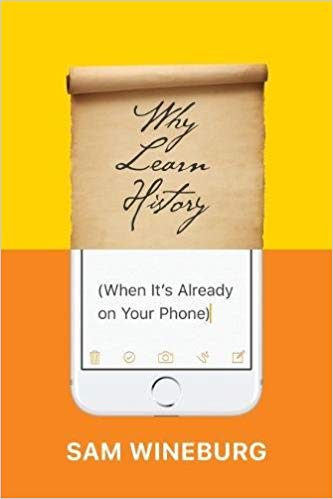Why Learn History (When It’s Already on Your Phone)
- By Sam Wineburg
- University of Chicago Press
- 240 pp.
- Reviewed by Larry Matthews
- September 10, 2018
This fact-filled guide may be better suited to teachers than lay readers.

Why Learn History (When It’s Already on Your Phone) is a history book about history; it’s not for everyday readers who think they’ll learn a little something about John Adams or Attila the Hun. I mention that to explain what the book is about: If you’re a history teacher, this book is for you.
One sometimes hears older people lament, “Kids these days don’t know much history; it’s not like it was in my day.” As it turns out, that’s something older people likely have been saying for a very long time — at least since 1917. In that year, researchers determined that U.S. high-school students retained only a third of the history they had been taught, including the key dates in the nation’s history. That tidbit is included in the opening of Sam Wineburg’s book, and illustrates why it’s a good investment.
Wineburg is a professor at Stanford University who has done groundbreaking work in the field of history education. His book examines the history of teaching history, as well as why students don’t retain what they’ve been taught. He notes, for example, that traditional teaching methods do not engage students to a degree that makes them want to learn more. Nor are students given the skills necessary to determine fact from fiction.
History, especially American, is about who we are and how we got here. Most of us learned history by sitting in a classroom while a teacher walked us through a textbook that may have contained factual errors. This is history from the point of view of people who had the power to determine the “truth.”
Wineburg offers examples of the struggle to present history as fact and to engage students in the search for context. One method he suggests is to move away from textbooks to original documents written by contemporaries of the time being studied; this brings the student closer to the historical time period and moves the teaching away from the dry text being explained by a teacher standing in front of a group. Thus, history becomes more tangible.
Similarly, the author highlights the popularity of Howard Zinn’s A People’s History of the United States, a bottom-up examination of America from the vantage point of slaves and others who were on the lowest rung of society as the country grew.
He notes that A People’s History was popular with students because many saw the book as “the truth”: “Zinn’s goal is to turn everything we know — or think we know — on its head.” Zinn’s book makes history live for many young readers.
These are the issues Wineburg raises in the first part of his book. The rest addresses the challenges of the digital age, when we can all click on a website and find “facts” that may not have any basis in reality.
In one study, “Students, as it turned out, used a simple rule for deciding what to believe: they forked over the responsibility to Google.” Not one participant verified the identifications or qualifications of the authors — whatever came up first was read and believed.
Historians, one would assume, would be more selective. Yet, in another study, relates Wineburg, 10 historians, all college professors, were given a battery of tasks to determine the validity of the digital information they found on two websites. How did they do? Not well: One of them based his positive opinion of a website on the fonts used at the site, saying, “I tend to go with classic fonts.”
It’s hard enough, Wineburg writes, to get the facts straight using trained teachers with text in a classroom, let alone on the Internet where everyone has a voice, qualified or not. “Most middle school students couldn’t distinguish between an ad and a news story,” he notes. Okay, they’re kids — but “59 per cent of adults couldn’t tell the difference either.”
This is critical in the Internet age when, as Wineburg says, “going to the library means turning on our laptops and making sure we have a wireless connection.” We can Google anything, but how do we know what we find is valid? “You need no one’s permission to create a website…Go ahead — be an author! What determines whether you go viral is not the blessing from some academic egghead, but from the digital mob.”
Wineburg’s message is important, but it comes in a loose envelope. His history of the teaching of history is interesting, but it’s hard to see how it ties in to other parts of the book. He devotes many pages to his own history as a student and teacher, also to little effect. I found myself asking where all of this was going; occasionally, it seemed as though he was gluing several unfinished books together.
This is, however, a book that might appeal to teachers and concerned parents who care enough to wade through what, at times, feels like a research paper. And Wineburg’s point about the Internet, at least, is clear. We live in an age of information that often is incorrect, misdirected, or misguided. Teaching students to find and appreciate the truth is, and will continue to be, a great challenge.
Larry Matthews is the author of Age in Good Time, Lives and Lessons from Seven Men in Their Seventies. He can be found at www.larrymatthews.net.

